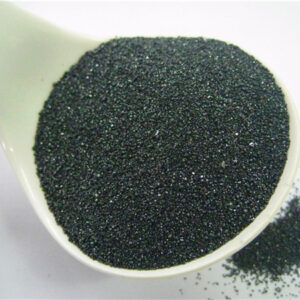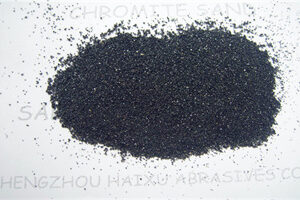Characteristics of chromite flour for magnesia-chrome refractory bricks mixed with magnesia sand
1. Chemical composition requirements
High Cr2O3 content: The Cr2O3 content in chromite flour is usually required to be ≥46%, which is the core component for the formation of magnesia-chrome spinel (MgO·Cr2O3), which directly affects the high temperature stability and corrosion resistance of refractory materials.
Low impurity control: The content of impurities such as SiO2 and CaO needs to be strictly controlled (<1%, <2.5%) to avoid the formation of low melting point silicate phases that affect the high temperature performance of the material.
2. Physical properties
Particle size and uniformity: It needs to be finely ground and processed, with a particle size of tens of microns and uniform distribution to ensure full mixing with magnesia sand and promote the uniform formation of spinel phase during sintering.
High density characteristics: The density is usually between 3.2-4.8g/cm3, which can improve the compactness and anti-penetration ability of refractory bricks.
High hardness and wear resistance: Mohs hardness 5.5-6.5, enhances the wear resistance of refractory bricks in high temperature environments.
3. Thermal and chemical properties
High temperature stability: The melting point is as high as 2150℃, and the sintering temperature needs to reach 1850℃ to ensure that the refractory bricks maintain structural stability under high temperature conditions.
Thermal shock resistance: Excellent thermal conductivity and low thermal expansion coefficient can buffer the stress caused by sudden temperature changes and prevent the bricks from cracking.
Alkaline corrosion resistance: It is chemically inert to alkaline slag (such as cement kiln environment) and can effectively resist the penetration of corrosive substances such as FeO.
4. Microstructural contribution
Spinel phase formation: Chromite flour reacts with magnesia sand at high temperature to form in-situ magnesium chromium spinel, and promotes the precipitation of secondary spinel phase in periclase to form a direct bonding structure, which significantly improves the slag resistance and high temperature strength of the material.
Composite reinforcement effect: Through the complex phase structure of spinel phase and periclase, the overall thermal conductivity is reduced and the thermal expansion coefficient is adjusted, and the thermodynamic properties of refractory bricks are comprehensively improved.
5. Process adaptability
Sintering compatibility: It needs to adapt to the firing temperature (1550-1750℃) of different processes (such as direct bonding and co-sintering) to ensure that the effective bonding of spinel can be achieved under high temperature conditions.
Environmental friendliness: The original minerals do not need chemical synthesis to avoid the generation of harmful substances such as hexavalent chromium, which meets environmental protection requirements.
The above characteristics jointly determine the core role of chromite flour in magnesia-chrome refractory bricks, which is directly related to the high temperature resistance, corrosion resistance and service life of refractory bricks.




















